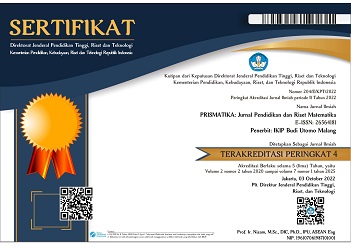IMPLEMENTASI MODEL PEMBELAJARAN BERBASIS PROYEK UNTUK MENGIDENTIFIKASI KEMAMPUAN BERPIKIR KREATIF MAHASISWA MATEMATIKA
Abstract
Advanced calculus is a mandatory subject in the Mathematics Study Program, Faculty of Science and Technology, Jambi University. Advanced Calculus studies functions of multiple variables, ordinary derivatives, partial derivatives, double integrals, fold integrals, applications of double integrals, triple integrals and applications of triple integrals. CPL from the advanced calculus course includes students being able to develop mathematical thinking starting from procedural/computational understanding to a broad understanding including exploration, logical reasoning, generalization, abstraction and formal proof. One learning model that facilitates students to fulfill the CPL for advanced Calculus courses is the project-based learning model (Project-based Learning). It is hoped that the Project-Based Learning model can be a learning alternative to help students think creatively in learning Advanced Calculus. It is hoped that the creative thinking abilities of Mathematics Study Program students will increase and support the fulfillment of CPL courses which will result in the formation of creative and systematic mathematics students who are skilled in solving problems and have the capabilities and competencies needed by the world of work (industry, services and government). The results of the analysis showed that the creative thinking abilities of students in class R001 were classified as creative and 1 group was very creative, while in R002 all groups were classified as very creative. The conclusions of this research show a tendency for students' creative thinking abilities to be in the creative category.
References
Kholijah, G., Sormin.Corry, & Z, G. (2023). Model Project Based Learning pada Mata Kuliah Metode Peramalan disekitar lingkungan serta diharuskan juga mahasiswa mampu untuk dimengerti . Sehingga hal ini mengharuskan adanya suatu proses inovasi. AKSIOMA: Jurnal Matematika Dan Pendidikan Matematika, 14(2), 209–220.
Ngalimun. (2012). Strategi dan Model Pembelajaran. Aswaja Pessindo.
Nugroho, G. A., Prayitno, B. A., Ariyanto, J., Keguruan, F., Sebelas, U., & Surakarta, M. (2017). Peningkatan Kemampuan Berpikir Kreatif Melalui Penerapan Project Based Learning Pada Materi Pencemaran dan Daur Ulang Limbah Enhancement of Creative Thinking Ability through the Implementation of Project Based Learning on Material and Waste Recycling. 6, 9–12.
Purnomo, A., Maria,kanusta, & Fitriyah. (2022). Pengantar Model Pembelajaran (Y. Muhammad (ed.); 1st ed.). YAYASAN HAMJAH DIHA.
Qurrotu’ain, A. Y. (2023). Keterampilan Berpikir Kreatif Matematis Dalam Pemeblajaran Berbasis Proyek (PjBL).
Rahayu, E., Susanto, H., & Yulianti, D. (2011). Pembelajaran Sains Dengan Pendekatan Keterampilan Proses Untuk Meningkatkan Hasil Belajar Dan Kemampuan Berpikir Kreatif Siswa. Jurnal Pendidikan Fisika Indonesia, 7(2), 106–110.
Saefudin, A., & Berdiati, I. (2014). Pembelajaran Efektif. Bandung: PT Remaja Roskadary.
Saidah, I., Dwijanto, & J, I. (2020). Kemampuan Berpikir Kreatif Siswa dalam Pembelajaran Matematika. Jurnal Ilmu Pendidikan, 2012, 1042–1045.
Surya, A. P., Relmasira, S. C., & Hardini, A. T. A. (2018). PENERAPAN MODEL PEMBELAJARAN PROJECT BASED LEARNING (PjBL) UNTUK MENINGKATKAN HASIL BELAJAR DAN KREATIFITAS SISWA KELAS III SD NEGERI SIDOREJO LOR 01 SALATIGA. Jurnal Pesona Dasar, 6(1), 41–54. https://doi.org/10.24815/pear.v6i1.10703
Ulger, K. (2017). THE RELATIONSHIP BETWEEN THE CREATIVITY AND THE CREATIVE THINKING SKILLS OBSERVED IN STUDENTS ’ PAINTING SKILLS THE RELATIONSHIP BETWEEN THE CREATIVITY AND THE CREATIVE THINKING SKILLS OBSERVED IN STUDENTS ’. November 2016.
Utami, A. K. D., & Kunaeni, E. (2016). Analisis Tingkat Kemampuan Berpikir Kreatif Pada Materi Geometri Ditinjau Dari Kemampuan Awal. Prosiding Seminar Matematika Dan Pendidikan Matematika, November, 360. https://repository.ar-raniry.ac.id/id/eprint/16119/1/Zakiatun Nufus%2C 160205091%2C FTK%2C PMA%2C 082274545718.pdf
Visi dan Misi Program Studi Matematika Fakultas Sains dan Teknologi Universitas Jambi. Diakses online pada tanggal 1 Maret 2024 dari https://matematikafst.unja.ac.id/index.php/kontak-saya/visi-dan-misi/
Wahyu, R., Islam, U., & Rahmat, R. (2018). Implementasi Model Project Based Learning ( PJBL ) Ditinjau dari Penerapan Implementasi Model Project Based Learning ( PJBL ) Ditinjau dari Penerapan Kurikulum 2013. Teknoscienza, 1(1), 50–62.
Yurinanda, Sherli. , Multahadah, C., & Z, Gusmanely. (2023). PENERAPAN MODUL BERBASIS PROJECT BASED LEARNING PADA MATA KULIAH ANALISIS REAL 2. Prismatika. 6(1), 111-120. https://doi.org/10.33503/prismatika.v6i1.3455
Yusuf, M. (2019). Pengaruh Kemajuan Teknologi dan Pengetahuan terhadap Minat Generasi Milenial dalam Berinvestasi di Pasar Modal. Jurnal Dinamika Manajemen Dan Bisnis, 2(2), 86-94.
Z, G., Multahadah, C., & Syafmen, W. (2023). Available online at : http://ijer.ftk.uinjambi.ac.id/index.php/ijer The Implementation ff Project Based Learning Model To Improve Problem-Solving Ability And Mathematics Coding System In Number Theory Course Available online at : http://ijer.ftk.uinjambi. 8(2), 86–90.
Zakiah, N. E., Fatimah, A. T., & Sunaryo, Y. (2020). Implementasi Project-Based Learning untuk Mengeksplorasi Kreativitas dan Kemampuan Berpikir Kreatif Matematis Mahasiswa. Teorema: Teori dan Riset Matematika, 5(2), 285–293.







.png)




